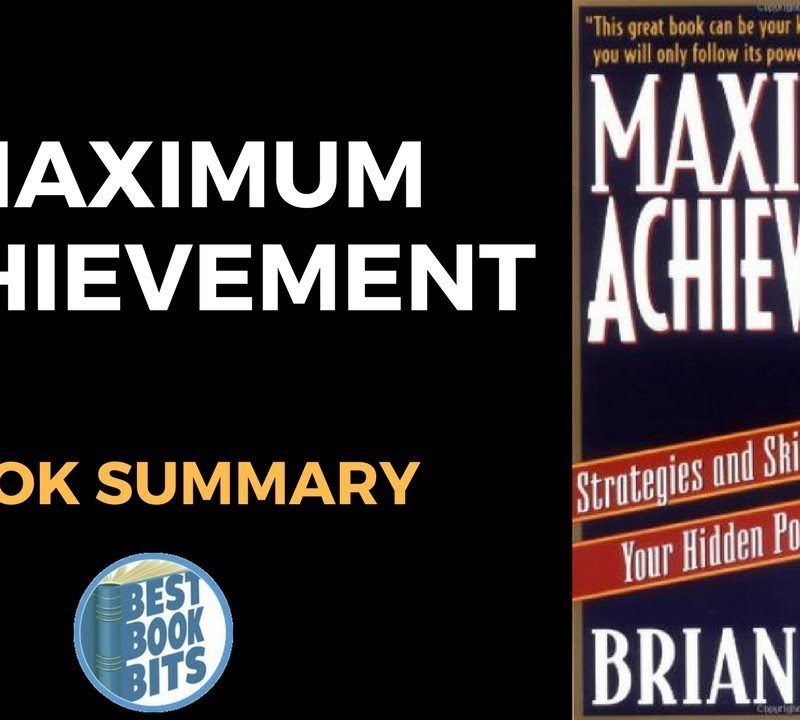♠ CLICK THIS TO JOIN THE ‘BEST BOOK CLUB’ NOW HERE TO MEET AUTHORS AND NEW FRIENDS
♣ CLICK THIS TO STOP TRYING TO ACHIEVE YOUR GOALS BY YOURSELF AND BE COACHED TODAY HERE
♥ CLICK THIS TO DOWNLOAD THIS FREE PDF SUMMARY HERE
♦ CLICK THESE FOR THE FOLLOWING Book | Summaries | Course
YouTube |Spotify | Instagram | Facebook | Newsletter | Website
How Full Is Your Bucket – Positive Strategies For Work & Life by Tom Rath & Donald O’ Clifton
In this brief but significant book, the authors, a grandfather – grandson team, explore how even the briefest positive interactions affect our relationships, productivity, health & longetivity. Did that person – your spouse, best friend, coworker, or even a stranger – “fill your bucket” by making you feel more positive? Or did that person “dip from your bucket”, leaving you more negative than before.
Organized around a simple metaphor of a dipper and a bucket, this book will show you how to greatly increase the positive moments in your work and your life – while reducing the negative. The book is a short, sharp, ‘how-to’ guide for improving self-esteem, better relationships, and health. This book is an invaluable guide for anyone trying to build a positive culture either in one’s own personal or professional life.
The authors while researching for the book discovered that our lives are shaped by our interactions with others. Whether we have a long conversation with a friend or simply place an order at a restaurant, every interaction makes a difference. The results of our encounters are rarely neutral; they are almost positive or negative. And although we take these interactions for granted, they accumulate and profoundly affect our lives. This book is based on the new emerging field of study ‘Positive Psychology’ which focuses on what is right’ with people.
The Theory of the Dipper and the Bucket: Each one of us has an invisible bucket. It is constantly emptied or filled, depending on what others say or do to us. When our bucket is full, we feel great. When it’s empty, we feel awful. Each of us also has an invisible dipper. When we use that dipper to fill other people’s buckets – by saying or doing things to increase their positive emotions – we also fill our own bucket.
But when use that dipper to dip from others buckets – by saying or doing things that decrease their positive emotions – we diminish ourselves. Like the cup that runneth over, a full bucket gives us a positive outlook and renewed energy. Every drop in that bucket makes us stronger and more optimistic. But an empty bucket poisons our outlook, saps our energy, and undermines our will.
That’s why every time someone dips from our bucket, it hurts us. So we face a choice every moment of every day: We can fill another’s buckets, or we can dip from them. It’s an important choice – one that profoundly influences our relationships, health, and happiness.
Chapter One – Negativity Kills: In this chapter, the authors illustrate the example of the kind of psychological torture that the American POWs suffered during the Korean War. 1000 American Prisoners of War had been detained in a North Korean Camp.
Here each man was subject to being in a mental “solitary confinement cell…without any steel or concrete.” The captors used extreme mental tactics. Their objective was to “deny men the emotional support that comes from interpersonal relationships.”
They used four primary tactics, i.e. informing, self-criticism, breaking loyalty to leadership and country, withholding all positive emotional support. The North Koreans had put the American Soldiers “into a kind of emotional and psychological isolation, the likes of which is never seen generally.”
By subtly eroding the caring, trust, respect, and social acceptance among the American soldiers, the North Koreans created an environment in which buckets of goodwill were constantly and ruthlessly drained. Relentless negativity resulted in a 38% POW death rate – the highest in U.S. military history.
Chapter Two – Positivity, Negativity, and Productivity: Moved by this story of psychological torture and deprivation – and perhaps inspired by the hope that these soldiers had not suffered or died in vain – the authors decided to study the flip side of this horrific equation.
They wondered: if people can be literally, destroyed by unrelenting negative reinforcement, can they be uplifted and inspired to a greater degree by similar levels of Positivity? In essence, they asked: Can Positivity have an even stronger impact than negativity? We all experience positive and negative interactions every day that influence how we feel and behave.
Just because these interactions are commonplace and often undramatic doesn’t mean they do not matter. They do. While most of our negative experiences will not kill us, they can slowly but surely erode our well-being and productivity. Fortunately, positive experiences or “bucket filling” can be even more powerful. “Recognition” and “Praise” are two most critical components for creating positive emotions in organizations.
Studies show that organizational leaders who share positive emotions have workgroups with a more positive mood, enhanced job satisfaction, greater engagement, and improved group performance. Individuals who receive regular recognition and praise increase their individual productivity, increase engagement among their colleagues, are more likely to stay with their organization, receive higher loyalty and satisfaction scores from customers, have better safety records and fewer accidents on job.
Although we need and want recognition and praise, the fact is, we don’t get enough – and organizations suffer because of it. Sincere and meaningful bucket filling increases the morale of any organization. Managers and employees who actively spread positive emotions, even in small doses, will see the difference immediately. And creating that difference can be inexpensive – or even free. All it takes is a little initiative.
♠ CLICK THIS TO JOIN THE ‘BEST BOOK CLUB’ NOW HERE TO MEET AUTHORS AND NEW FRIENDS
♣ CLICK THIS TO STOP TRYING TO ACHIEVE YOUR GOALS BY YOURSELF AND BE COACHED TODAY HERE
♥ CLICK THIS TO DOWNLOAD THIS FREE PDF SUMMARY HERE
♦ CLICK THESE FOR THE FOLLOWING Book | Summaries | Course
YouTube |Spotify | Instagram | Facebook | Newsletter | Website
Chapter Three – Every Moment Matters: Usually we don’t stop to consider the impact of brief interactions. But we experience literally hundreds of potential turning points in a given day. We experience approximately 20,000 individual moments every day. Most of us want more positive emotions in our lives.
Ninety – nine out of every 100 people report that they want to be around more positive people. 9 out 10 people say they are more productive when they’re around positive people. The authors introduce a new field of study and research – The Positive Psychology movement – the study of what is right with people.
Recent studies show that negative emotions can be harmful to your health and might even shorten your life span. In contrast, positive emotions are an essential daily requirement for survival. Not only, do they improve one’s physical and mental health, but they can also provide a buffer against depression and illness.
A word of caution, the authors mention that while this book focuses primarily on ways to increase positive emotions, it’s important to note that negativity & weaknesses must not be ignored, Positivity must be grounded in reality. A “Pollyana” approach, in which the negative is completely ignored, can result in a false optimism that is counterproductive and sometimes downright annoying.
There are times when it is absolutely necessary to correct our mistakes and figure out how to manage our weaknesses. The authors suggest the magic ratio: 5 positive interactions for every 1 negative interaction. Positive emotions are not trivial luxuries, but instead may be critical necessities for optimal functioning. Positive emotions protect us from, and can undo the effects of, negative emotions.
They fuel resilience and can transform people, broaden our thinking, encouraging us to discover new lines of thought or action, they break down racial barriers, build durable physical, intellectual, social, and psychological resources that can function as “reserves” during trying times, produce optimal functioning in organizations and individuals, improve the overall performance of a group when leaders express more positive emotions.
Chapter Four – An Overflowing Bucket: Positivity and Negativity are primarily rooted in nature; others argue for nurture. The most common theory right now is that both nature and nurture make a significant, and possibly equal, contribution. Our level of positive emotions can certainly rise or fall a great deal based on what happens to us over a period of time.
And it would hurt most of us to go on a diet consisting of more positive emotions and fewer negative emotions. Regardless of an individual’s innate starting point, regular bucket filling can increase his or her positive emotions. To illustrate the long-term impact, Tom Rath, one of the co-author shares his own personal story.
As the first child of his generation in a large, extended family, he benefited from a unique method of childhood rearing. From the day that he was born, each member of his family was determined to help him focus on what he did best. They provided constant support and encouragement. By the time, he turned four, his mother and grandmother had spotted his keen interest in reading.
So they would sit with him for hours on end, helping him learn to read. This teaching, nurturing, and attention made a real difference. It was easy to see that they were looking for early cues to his natural yearnings and talents. They encouraged him to learn as much as possible on his favorite reading topic. They were never shy with their praise and always quick to compliment even the smallest accomplishments.
All of the caring, attention, and genuine bucket filling was making a major difference in his life. His bucket was overflowing, and this allowed him to concentrate on filling the buckets of everyone around him. The focus was on positive encouragement, more on the areas that gave him personal satisfaction.
At the age of 16, Tom was diagnosed with an extremely rare disorder: von Hippal – Lindau disease. Tumors were discovered in his eye and several major surgeries performed. He lost sight in his left eye permanently. There were possibilities that tumors were likely to show up in his pancreas, kidneys, eardrums, adrenal glands, brain, and spine, with no advance warning. Upon hearing this news for the first time, Tom was shocked and nervous.
But, on some level, the news did not dampen his spirits. From that day forward, instead of dwelling on the negative or uncontrollable aspects of his disease, his family helped him focus on what could be done. He never got depressed. The kind of genuine caring and Positivity that he received had a remarkable influence.
The key was not viewing his prognosis as any type of curse or death sentence. He instead saw it as an opportunity to be proactive and stay on top of his physical health. His approach was to confront these challenges head-on. He researched as many articles as he could find on each of his condition, wanting to fully understand his surgical options and the associated risks.
He maintained a vigil and awareness of his disease. All of his energy was focused on what could be done. His energy was not focused on what had already occurred or aspects beyond his control. The author mentions that to this day, he never stopped in his tracks and asked, “Why did all of this happen to me?”
He never rallied against fate. He saw no good reason to sit around and dwell on the negative or feel sorry for himself on those situations. It would get him nowhere. Besides, such wallowing could have worsened his emotional and physical health, the author feels.
He says that he sees no alternative other than to focus on what can be done next to stay ahead of his disease. Honestly, it’s easy to maintain this attitude on a daily basis. It’s simple. After almost three decades of life, he cannot recall a single day when his bucket wasn’t filled over and over again by family members and friends.
Given his ongoing physical challenges, this high-dose bucket filling has literally been a lifesaver for him.
We are all certain to face major challenges as we progress through life. Often, we feel as if we have been “dealt a bad hand” and that life is unfair. But we must not allow ourselves to be defined by our hardships.
Our responses to difficult events and our emotional states are much more important. Positive reinforcement about our strengths can buffer us against getting overwhelmed with the negative. And understanding what we do best allows us not only to survive, but grow in the face of adversity.
♠ CLICK THIS TO JOIN THE ‘BEST BOOK CLUB’ NOW HERE TO MEET AUTHORS AND NEW FRIENDS
♣ CLICK THIS TO STOP TRYING TO ACHIEVE YOUR GOALS BY YOURSELF AND BE COACHED TODAY HERE
♥ CLICK THIS TO DOWNLOAD THIS FREE PDF SUMMARY HERE
♦ CLICK THESE FOR THE FOLLOWING Book | Summaries | Course
YouTube |Spotify | Instagram | Facebook | Newsletter | Website
Chapter Five – Making it Personal: There are countless examples of people whose lives were made better and more productive by frequent bucket filling. The key to great bucket filling: Recognition is most appreciated and effective when it is individualized, specific, and deserved. Some may prefer a quiet pat on the back or perhaps more boisterous praise in a meeting.
The point is there are unique and specific ways to fill each person’s bucket – and most certainly inappropriate ways as well. Generic, one size fits all awards don’t work. Neither does recognition that seems forced or false. People look for a more meaningful and personal kind of recognition.
The authors mention that if you want people to understand that you value their contributions and that they are important, the recognition and praise that is provided must have meaning that is specific to each individual. Not only is individualized bucket filling more effective in boosting productivity in the workplace, it builds sustainable relationships and changes people’s lives forever.
Chapter Six – Five Strategies for increasing Positive Emotions: To increase positive emotions in our lives and other’ lives, one has to make the habit of filling buckets. Like any goal in life, one must have specific, actionable plans to transform good intentions into reality. The five strategies are:
- Prevent Bucket Dipping: Get into the simple habit of asking yourself if you were adding to or taking from the other person’s bucket in each interaction. By catching yourself before uttering a negative comment – and in some cases making a more positive one instead – you will make yourself and the people around you, feel better.
Once you have successfully curtailed your own bucket dipping, encourage similar changes among those around you. Convince others that unwarranted negativity only makes matters worse. Once you’ve consciously started to eliminate bucket-dipping, keep track of your progress by scoring your interactions. That’s right: Reflect on your last few exchanges with another person. Decide if, overall, each interaction was more positive or negative.
- Shine a Light on What is Right: Each interaction gives us the chance to shine a light on what’s right – and fill a bucket. Discover the power of focusing on what is right. Never underestimate the long-term influence of filling others’ buckets. Positive emotions create “chains of interpersonal events,” the far – reaching results of which one may or may not get to see in person. But they are there and happening.
Every time you fill a bucket, you’re setting something in motion. So continue the chain: When someone fills your bucket, accept it – never just brush it off and diminish what that person is doing. Fill their bucket in return by saying “thank you,” letting them know that you appreciate the compliment or recognition. In turn, you are more likely to share your renewed positive energy with others.
- Make Best Friends: Most of us join and stay with groups, teams, and organizations because of our best friends. We say “best friend” because studies of great workplaces found that having “friends,” “good friends,” or “close friends” on the job was not as important as having “a bestfriend at work.” People with best friends at work have better safety records, receive higher customer satisfaction scores, and increase workplace productivity.
Great relationships lead to a significant increase in life satisfaction. Consider some of your best relationships. They were probably formed through and early series of positive interactions. You’re not likely to become good friends with someone if the majority of the initial interactions are negative. The authors tell to us that begin with the most important people in your life.
Tell them how important they are to you and why. Don’t assume they already know – even if they do, they’d probably love to hear it anyway. Continue to learn more about what builds them up; be a catalyst for an even more trusting, lasting, and positive relationship. Learn something new about each person you work or interact with. Create positive interactions with acquaintances – even strangers.
- Give unexpectedly: The vast majority of people prefer gifts that are unexpected. It’s about the element of surprise. And the gift doesn’t have to be anything big or tangible to be successful. It can be a gift of trust or responsibility. Sharing something personal or entrusting a friend with a secret can fill his or her bucket.
Even a smile can be an unexpected and cherished gift. Consider unexpected sharing as well. What books, articles, or stories could you send someone that would positively influence his or her day?
- Reverse the Golden Rule: When it comes to robust and meaningful bucket filling, individualization is the key. So when you’re bucket filling, go ahead and reverse – or at least redefine – the Golden Rule. While certain people want to receive kind words in front of a crowd, others prefer a quieter, one-to-one commendation or compliment from someone they love, admire, or respect.
Another important aspect of individualization is this: What we recognize in others helps them shape their identity and their future accomplishments. This is why bucket filling must be specific to the individual. In addition to being individualized, it will mean more to the recipient if the praise is specific.
Putting praise into writing or email is a great way to do this. Written recognition is also especially rewarding because it serves as a lasting acknowledgement – something the recipient can reflect on over and over again.
Conclusion: One can expect the following changes to occur if engaged in daily bucket filling. The workplace will be a lot more productive and fun. You’ll have more friends. Your colleagues and customers will be more satisfied and engaged. Your marriage will be stronger. You’ll enjoy closer relationships with your family and friends.
You’ll be healthier, happier, and well on your way to a longer life. Take every opportunity to increase the positive emotions of those around you. It will make a big difference. It may even change the world. Don’t waste another moment. A bucket, somewhere, is waiting for you to fill it.
♠ CLICK THIS TO JOIN THE ‘BEST BOOK CLUB’ NOW HERE TO MEET AUTHORS AND NEW FRIENDS
♣ CLICK THIS TO STOP TRYING TO ACHIEVE YOUR GOALS BY YOURSELF AND BE COACHED TODAY HERE
♥ CLICK THIS TO DOWNLOAD THIS FREE PDF SUMMARY HERE
♦ CLICK THESE FOR THE FOLLOWING Book | Summaries | Course
YouTube |Spotify | Instagram | Facebook | Newsletter | Website













